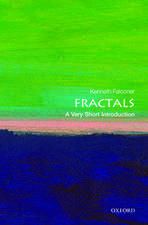Fractals for the Classroom: Part Two: Complex Systems and Mandelbrot Set
Autor Heinz-Otto Peitgen, Hartmut Jürgens, Dietmar Saupeen Limba Engleză Hardback – 26 aug 1992
| Toate formatele și edițiile | Preț | Express |
|---|---|---|
| Paperback (2) | 408.54 lei 6-8 săpt. | |
| Springer – 26 sep 2011 | 408.54 lei 6-8 săpt. | |
| Springer – 8 dec 2012 | 501.99 lei 6-8 săpt. | |
| Hardback (1) | 419.52 lei 6-8 săpt. | |
| Springer – 26 aug 1992 | 419.52 lei 6-8 săpt. |
Preț: 419.52 lei
Nou
Puncte Express: 629
Preț estimativ în valută:
80.28€ • 85.84$ • 66.93£
80.28€ • 85.84$ • 66.93£
Carte tipărită la comandă
Livrare economică 18 aprilie-02 mai
Preluare comenzi: 021 569.72.76
Specificații
ISBN-13: 9780387977225
ISBN-10: 0387977228
Pagini: 500
Ilustrații: XII, 500 p.
Dimensiuni: 178 x 254 x 34 mm
Greutate: 1.16 kg
Ediția:1992
Editura: Springer
Colecția Springer
Locul publicării:New York, NY, United States
ISBN-10: 0387977228
Pagini: 500
Ilustrații: XII, 500 p.
Dimensiuni: 178 x 254 x 34 mm
Greutate: 1.16 kg
Ediția:1992
Editura: Springer
Colecția Springer
Locul publicării:New York, NY, United States
Public țintă
Lower undergraduateCuprins
Introduction: Causality Principle, Deterministic Laws and Chaos.- 8 Recursive Structures: Growing of Fractals and Plants.- 8.1 L-Systems: A Language For Modeling Growth.- 8.2 Growing Classical Fractals with MRCMs.- 8.3 Turtle Graphics: Graphical Interpretation of L-Systems.- 8.4 Growing Classical Fractals with L-Systems.- 8.5 Growing Fractals with Networked MRCMs.- 8.6 L-System Trees and Bushes.- 8.7 Program of the Chapter: L-systems.- 9 Pascal’s Triangle: Cellular Automata and Attractors.- 9.1 Cellular Automata.- 9.2 Binomial Coefficients and Divisibility.- 9.3 IFS: From Local Divisibility to Global Geometry.- 9.4 Catalytic Converters or how many Cells are Black?.- 9.5 Program of the Chapter: Cellular Automata.- 10 Deterministic Chaos: Sensitivity, Mixing, and Periodic Points.- 10.1 The Signs of Chaos: Sensitivity.- 10.2 The Signs of Chaos: Mixing and Periodic Points.- 10.3 Ergodic Orbits and Histograms.- 10.4 Paradigm of Chaos: The Kneading of Dough.- 10.5 Analysis of Chaos: Sensitivity, Mixing, and Periodic Points.- 10.6 Chaos for the Quadratic Iterator.- 10.7 Numerics of Chaos: Worth the Trouble or Not?.- 10.8 Program of the Chapter: Time Series and Error Development.- 11 Order and Chaos: Period-Doubling and its Chaotic Mirror.- 11.1 The First Step From Order to Chaos: Stable Fixed Points.- 11.2 The Next Step From Order to Chaos: The Period Doubling Scenario.- 11.3 The Feigenbaum Point: Entrance to Chaos.- 11.4 From Chaos to Order: a Mirror Image.- 11.5 Intermittency and Crises: The Backdoors to Chaos.- 11.6 Program of the Chapter: Final State Diagram.- 12 Strange Attractors: The Locus of Chaos.- 12.1 A Discrete Dynamical System in Two Dimensions: Hénon’s Attractor.- 12.2 Continuous Dynamical Systems: Differential Equations.- 12.3 The Rössler Attractor.- 12.4The Lorenz Attractor.- 12.5 The Reconstruction of Strange Attractors.- 12.6 Fractal Basin Boundaries.- 12.7 Program of the Chapter: Rössler Attractor.- 13 Julia Sets: Fractal Basin Boundaries.- 13.1 Julia Sets as Basin Boundaries.- 13.2 Complex Numbers — A Short Introduction.- 13.3 Complex Square Roots and Quadratic Equations.- 13.4 Prisoners versus Escapees.- 13.5 Equipotentials and Field Lines for Julia Sets.- 13.6 Chaos Game and Self-Similarity for Julia Sets.- 13.7 The Critical Point and Julia Sets as Cantor Sets.- 13.8 Quaternion Julia Sets.- 13.9 Program of the Chapter: Julia Sets.- 14 The Mandelbrot Set: Ordering the Julia Sets.- 14.1 From the Structural Dichotomy to the Potential Function.- 14.2 The Mandelbrot Set — A Road Map for Julia Sets.- 14.3 The Mandelbrot Set as a Table of Content.- 14.4 Program of the Chapter: The Mandelbrot Set.













